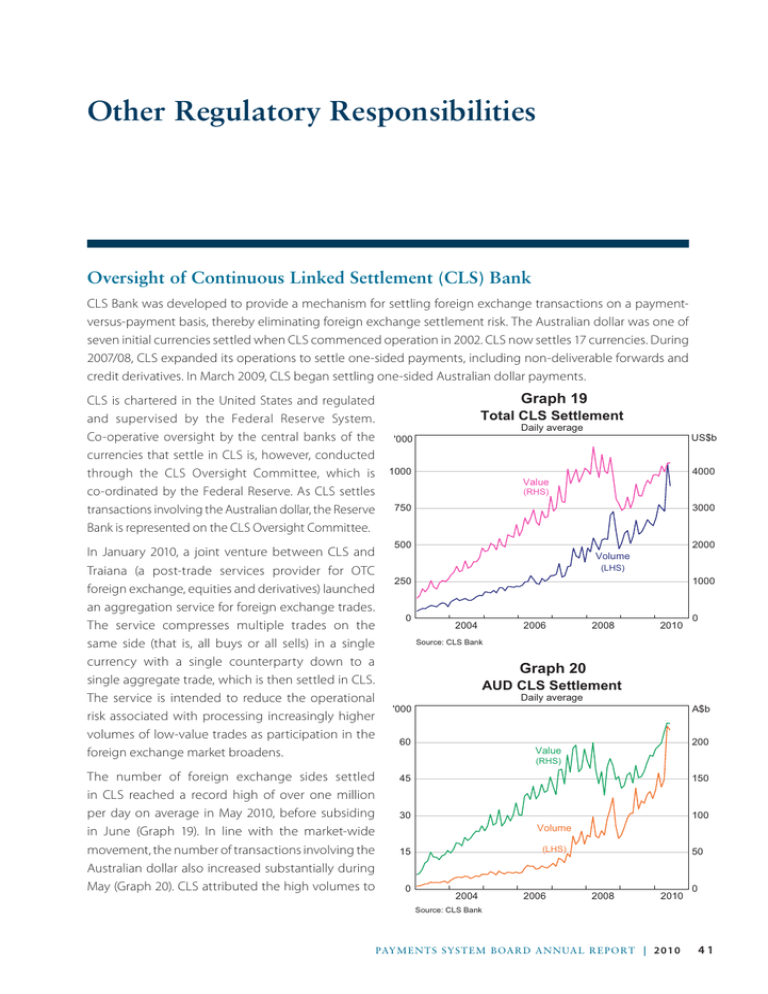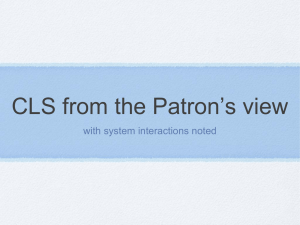Other Regulatory Responsibilities Oversight of Continuous Linked Settlement (CLS) Bank
advertisement

Other Regulatory Responsibilities Oversight of Continuous Linked Settlement (CLS) Bank CLS Bank was developed to provide a mechanism for settling foreign exchange transactions on a paymentversus-payment basis, thereby eliminating foreign exchange settlement risk. The Australian dollar was one of seven initial currencies settled when CLS commenced operation in 2002. CLS now settles 17 currencies. During 2007/08, CLS expanded its operations to settle one-sided payments, including non-deliverable forwards and credit derivatives. In March 2009, CLS began settling one-sided Australian dollar payments. CLS is chartered in the United States and regulated and supervised by the Federal Reserve System. Co-operative oversight by the central banks of the currencies that settle in CLS is, however, conducted through the CLS Oversight Committee, which is co-ordinated by the Federal Reserve. As CLS settles transactions involving the Australian dollar, the Reserve Bank is represented on the CLS Oversight Committee. In January 2010, a joint venture between CLS and Traiana (a post-trade services provider for OTC foreign exchange, equities and derivatives) launched an aggregation service for foreign exchange trades. The service compresses multiple trades on the same side (that is, all buys or all sells) in a single currency with a single counterparty down to a single aggregate trade, which is then settled in CLS. The service is intended to reduce the operational risk associated with processing increasingly higher volumes of low-value trades as participation in the foreign exchange market broadens. The number of foreign exchange sides settled in CLS reached a record high of over one million per day on average in May 2010, before subsiding in June (Graph 19). In line with the market-wide movement, the number of transactions involving the Australian dollar also increased substantially during May (Graph 20). CLS attributed the high volumes to Graph 19 Total CLS Settlement Daily average '000 1000 US$b 4000 Value (RHS) 750 3000 500 2000 Volume (LHS) 250 0 1000 2004 2006 2008 2010 0 Source: CLS Bank Graph 20 AUD CLS Settlement Daily average '000 60 A$b 200 Value (RHS) 45 150 30 100 Volume (LHS) 15 0 2004 2006 50 2008 2010 0 Source: CLS Bank PAYME N Ts sYs TE M B oAr d AN N UAL r E P o rT | 2010 41 sustained volatility in the market. This volatility was possibly driven by sovereign debt concerns in Europe, which heightened during the month. Notably, there was no commensurate increase in the average daily value of sides settled in May, indicating a fall in the average transaction size. CLS noted that this highlighted the impact of algorithmic trading in the market. Exchange Settlement Accounts The Payments System Board has ongoing responsibility for the Bank’s policy on access to ES accounts. These accounts provide a means for ultimate settlement of interbank obligations via the exchange of a settlement asset that carries no credit risk – a deposit held with the Reserve Bank. Under current policy, to be eligible to hold an ES account an institution must be a provider of third-party (customer) payment services with a need to settle clearing obligations with other providers, and able to demonstrate that they have the liquidity to meet settlement obligations under routine conditions, during seasonal peaks and under periods of stress. In general, applicants must be current or prospective members of a payments clearing arrangement or operate a clearing house which acts as a CCP. ES accounts are provided only for settlement of obligations from the clearing process. Depending on whether an institution is subject to supervision by APRA, the nature of its operations and the extent of its payments experience, it may be subject to collateral requirements as a condition of holding an ES account. Authorised Deposit-taking Institutions that account for at least 0.25 per cent of all RTGS payments are required to settle on their own behalf. Smaller institutions may elect to settle using another ES account holder as an agent. A full list of ES account holders is available on the Bank’s website. Approvals under the Payment Systems and Netting Act 1998 Under the Payment Systems and Netting Act, the Reserve Bank has the power to approve multilateral netting arrangements in order to protect the netting undertaken in these arrangements from legal challenge in the event that a party to such arrangements enters external administration.12 In the absence of approval, such arrangements entail a risk that surviving participants may be forced to pay their gross obligations to the defaulting institution with the prospect of receiving nothing in return. BPAY operates a payment system for bill payments which involves a multilateral netting arrangement. The settlement of BPAY obligations is currently achieved through an APCA clearing stream that has been approved under the Payment Systems and Netting Act. (The Reserve Bank has previously approved the multilateral netting arrangements applying to the clearing systems operated by APCA, the equity settlement system operated by ASX Settlement (formerly ASX Settlement and Transfer Corporation), and the fallback arrangements for Austraclear settlement if RITS is not available.) Nevertheless, without approval under the Payment Systems and Netting Act, BPAY’s multilateral netting arrangement is subject to some uncertainty in the event of a participant default. Accordingly, BPAY applied to the Bank for approval of its netting arrangements under the Payment Systems and Netting Act. As BPAY is a widely used payment system, the legal robustness of its netting arrangements 12 The Payment Systems and Netting Act also gives the Reserve Bank the power to approve an RTGS system (which includes securities settlement systems), thereby granting protection to transactions in that system from a possible ‘zero hour’ ruling. Under this rule, a court may date the bankruptcy of an institution from the midnight before the bankruptcy order was made; transactions settled between midnight and the time of the bankruptcy order would be void. The application of this rule would threaten the irrevocable nature of RTGS transactions. The Board has previously approved the RTGS systems, RITS, Austraclear and CHESS RTGS, for this purpose. 42 r Es Erv E BA Nk of AU s T rA L i A is important to the smooth functioning of the financial system. Given this, and having regard to the criteria for approvals set out in the Payment Systems and Netting Act, the Payments System Board approved BPAY’s application at its November 2009 meeting, subject to a number of rule changes being made by BPAY. Once these changes are made, the Reserve Bank will issue a formal approval. PAYME N Ts sYs TE M B oAr d AN N UAL r E P o rT | 2010 43 44 r Es Erv E BA Nk of AU s T rA L i A




